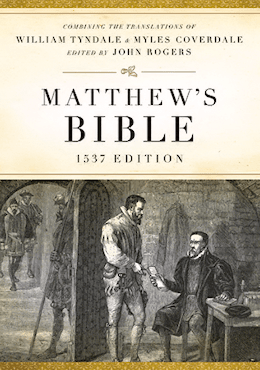Textus Receptus Bibles
Matthew's Bible 1537
| 6:1 | Let as manye seruauntes as are vnder the yoke, count theyr maysters worthy of all honoure that the name of God and hys doctryne be not euyll spoken of. |
| 6:2 | Se that they whiche haue beleuynge maysters, despyse them not because they are brethren: but so muche the rather do seruyce, for asmuch as they are beleuynge and beloued and partakers of the benefyte. |
| 6:3 | These thynges teache and exhorte. Yf any man teache otherwyse, and is not contente wt the holsome wordes of our Lord Iesus christ, and wyth the doctryne of Godlynes, |
| 6:4 | he is puft vp, and knoweth nothyng: but wasteth hys braynes about questyons and stryfe of wordes, whereof sprynge enuye, stryfe, raylynges, euyll surmysynges |
| 6:5 | and vayne disputacyons of men wyth corrupte myndes, and destytute of the trueth, whiche thynke that lucre is Godlines, from suche separate thy self. |
| 6:6 | Godlynes is greate ryches, yf a man be content with that he hath. |
| 6:7 | For we broughte nothynge into thys worlde & it is a playne case that we can carye nothyng out. |
| 6:8 | When we haue fode and raymente, let vs therwyth be content. |
| 6:9 | They that wyll be rych, fall into temptacyon and snares, and into many folysh and noysome lustes which drowne men in perdicyon and destruccyon. |
| 6:10 | For couetousnes is the rote of all euyll, whiche whyle some lusted after, they erred from the faythe and tangled them selues wyth manye sorowes. |
| 6:11 | But thou which arte the man of GOD, flye suche thynges. Folowe ryghtuousnes. Godlynes, loue, pacyence and mekenes. |
| 6:12 | Fyghte the good fyght of fayth. Laye hande on eternall lyfe, wherevnto thou arte called and hast professed a good professyon before manye wytnesses. |
| 6:13 | I geue the charge in the syght of GOD, whiche quickeneth all thynges, & before Iesu Christe whiche vnder Poncyus Pylate wytnessed a good wytnessynge, |
| 6:14 | that thou kepe the commaundement, and be wythout spot and vnrebukeable, vntyll the appearynge of our Lorde Iesus, |
| 6:15 | whiche appearynge (when the tyme is come) he shal shew that is blessed and myghtye onelye, kynge of kynges, & Lord of Lordes, |
| 6:16 | whiche onelye hath immortalitie, and dwelleth in lyght that no man can attayne, whome neuer man sawe, neyther can se, to whom be honoure and rule euerlastynge. Amen. |
| 6:17 | Charge them that are ryche in this worlde shal they be not exceadyng wyse, and that they truste not in the vncertayne ryches, but in the lyuyng God, which geueth vs aboundauntly al thynges to enioy them, |
| 6:18 | and that they do good and be ryche in good workes, and readye to geue and to distrybute, |
| 6:19 | layinge vp in store for them selues a good foundacyon agaynste the tyme to come that they maye obtayne eternal lyfe. |
| 6:20 | O Timothe saue that whiche is geuen the to kepe, and auoyde vnghostlye vanytyes of voyces and opposicyons of science falslye so called, |
| 6:21 | whiche science whyle some professed, they haue erred as concernyng the fayth. Grace be with the. AMEN. |

Matthew's Bible 1537
The Matthew Bible, also known as Matthew's Version, was first published in 1537 by John Rogers, under the pseudonym "Thomas Matthew". It combined the New Testament of William Tyndale, and as much of the Old Testament as he had been able to translate before being captured and put to death, with the translations of Myles Coverdale as to the balance of the Old Testament and the Apocrypha, except the Apocryphal Prayer of Manasses. It is thus a vital link in the main sequence of English Bible translations.